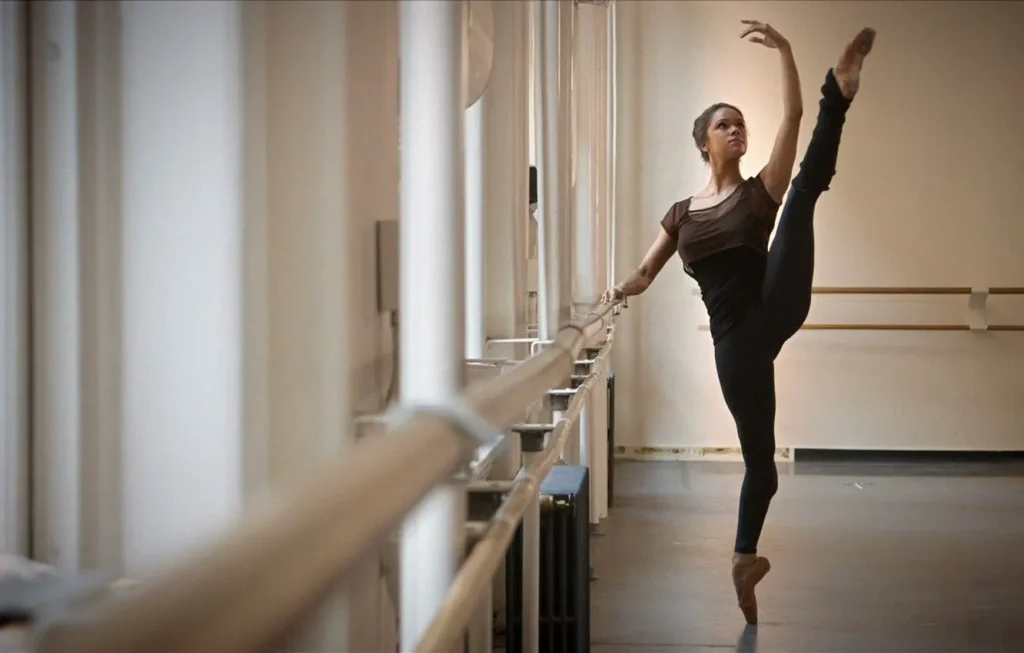Breaking News: Ballet Legend Misty Copeland Takes Final Bow at American Ballet Theatre
On October 22, 2025, Misty Copeland, the groundbreaking American Ballet Theatre (ABT) principal dancer, performed her final show with the prestigious company at Lincoln Center’s David H. Koch Theater in New York City. The historic retirement gala marked the end of a remarkable 25-year career that forever changed the landscape of classical ballet in America.
The 43-year-old ballerina, who made history a decade ago as the first Black female principal dancer in ABT’s 75-year history, returned to the stage after a five-year hiatus for this emotional farewell performance. The star-studded gala, which also celebrated ABT’s 85th anniversary, drew hundreds of devoted ballet fans who lined up for hours to witness this pivotal moment in dance history.
While gala tickets sold for $5,000, ABT ensured accessibility by offering free tickets to a simulcast at nearby Alice Tully Hall. Among those who traveled to attend was 10-year-old Kennedy Johnson from Atlanta, who told reporters she hoped to become a principal dancer “just like you.”
Oprah Winfrey and Debbie Allen Honor Ballet Icon
The retirement gala featured emotional tributes from entertainment luminaries including media mogul Oprah Winfrey and legendary choreographer Debbie Allen. Winfrey declared from the stage: “Misty didn’t just perform ballet. She changed it. She redefined who belongs, who gets to be seen, and who gets to lead.”
This sentiment explained why Copeland rose beyond an exceptional dancer. She became a cultural icon and ambassador for diversity. Her work was crucial in an art form that historically lacked representation of dancers of color.

The Unlikely Journey: From Poverty to Principal Dancer
Misty Copeland’s path to becoming a world-renowned ballet dancer defied conventional expectations. Born on September 10, 1982, in Kansas City, Missouri, she was raised in San Pedro, California. Her single mother struggled to support six children, leading to periods of poverty and homelessness.
Unlike most professional ballet dancers who begin training as toddlers, Copeland started ballet at age 13 at a Boys & Girls Club of America—considered exceptionally late by industry standards. Yet her natural talent and extraordinary work ethic were undeniable. Her late start, rather than being a limitation, became part of her inspirational narrative that resonated with aspiring dancers worldwide.
Career Milestones at American Ballet Theatre
- 2000: Joined ABT Studio Company
- 2001: Entered ABT corps de ballet at age 18
- 2007: Promoted to soloist, becoming the company’s second African American female soloist
- 2015: Made history as ABT’s first Black female principal dancer in the company’s 75-year history
Her 2015 promotion was announced at a special news conference—an unprecedented move that testified to her celebrity status both within and beyond the dance world. Learn more about American Ballet Theatre’s history and dancers.
Magnetic Stage Presence and Artistic Excellence
Pulitzer Prize-winning dance critic Sarah L. Kaufman described Copeland as “magnetic” on stage, noting her exceptional ability to command attention. “She’s very small, she’s petite, but onstage she just unfolds into this large scale presence,” Kaufman observed. “She was the kind of dancer you could not take your eyes off of, long before she became a principal.”
Beyond possessing the classic ballerina dimensions—hyperextended legs, flexibly arched feet, and an elegant long neck—Copeland brought remarkable liveliness and emotional depth to her movements. Her performances captivated both ballet purists and newcomers to the art form.
Iconic Ballet Roles and Performances
Copeland’s artistic range shone through her performances in legendary roles:
- Swan Lake: Her 2015 New York debut as Odette/Odile at the Metropolitan Opera House drew diverse and enthusiastic crowds
- Romeo and Juliet: Showcased her dramatic abilities and romantic expressiveness
- Firebird: The title role became one of her signature performances, attracting unprecedented diverse audiences to ABT
- Contemporary works: Excelled in modern pieces by choreographers Kyle Abraham and Marcelo Gomes

Her versatility extended beyond classical ballet. Copeland performed on Broadway in On the Town, appeared in music videos with Prince and Drake, and co-founded Life in Motion Productions, demonstrating the expanding artistic possibilities for ballet dancers in the 21st century.
The Historic Farewell Performance: October 22, 2025
The retirement gala, largely curated by Copeland herself, featured an emotionally charged program celebrating her career’s defining moments. She performed excerpts from “Romeo and Juliet” with partner Calvin Royal III, who in 2020 became ABT’s first Black male principal dancer in two decades—a testament to the doors Copeland helped open.
The duo also performed “Wrecka Stow,” a contemporary duet choreographed by Kyle Abraham. For her final dance, Copeland performed Twyla Tharp’s “Sinatra Suite” with longtime partner Herman Cornejo, bringing her storied ABT career to a poignant close.
The evening concluded with golden confetti raining from the rafters as colleagues, teachers, friends, and family presented Copeland with hugs and bouquets. Her 3-year-old son, Jackson, appeared in a tuxedo to embrace his mother during the emotional curtain calls, creating an unforgettable family moment witnessed by hundreds.
Beyond Ballet: Author, Producer, and Philanthropist
While Copeland’s performing career with ABT has concluded, her influence continues through multiple channels:
The Misty Copeland Foundation
Founded in 2021, The Misty Copeland Foundation advances diversity and access in dance education through its signature BE BOLD program. This after-school initiative now operates at 15 community organization sites in the Bronx and Harlem, providing children in under-resourced communities opportunities to engage with dance and ballet.
“Although I’ll be saying farewell to the stage, I’ll always be committed to opening doors, creating space, and making ballet a place where everyone belongs,” Copeland wrote in a public Instagram post before her final performance.
Published Author and Media Producer
Copeland is a New York Times bestselling author. The second volume of her “Bunheads” series was released in September 2025. Her memoir, Life in Motion: An Unlikely Ballerina, has inspired countless readers with its honest portrayal of her journey from poverty to prominence.
As a film producer and co-founder of Life in Motion Productions, she continues to create content that expands representation in entertainment and arts.
The Representation Question: Who Comes Next?
One sobering reality emerged from Copeland’s retirement announcement: American Ballet Theatre will no longer have a Black female principal dancer. When asked about this concern in a June 2025 interview, Copeland acknowledged the challenge while expressing optimism about her evolving role.
“I think I’ve just gotten to a place in my career where there’s only so much I can do on a stage,” she explained. “There’s only so much that visual representation can do. I feel like it’s the perfect timing for me to be stepping into a new role, and hopefully still shaping and shifting the ballet world and culture.”
Susan Jaffe, ABT’s artistic director, emphasized Copeland’s lasting impact: “Misty Copeland’s influence reaches far beyond her extraordinary performances. On stage, she broke barriers and redefined what it means to be a ballerina, inspiring generations with her artistry, strength, and grace.”

Cultural Impact: Changing the Face of Classical Ballet
Misty Copeland’s significance extends far beyond technical excellence. She became a symbol of possibility, proving that talent transcends race and that starting late doesn’t preclude greatness. Her presence helped major ballet companies like American Ballet Theatre and New York City Ballet increase representation of Black dancers.
Contemporary dancers like Ingrid Silva, Harper Watters, and India Bradley have performed coveted roles and garnered hundreds of thousands of online followers—changes partially attributable to Copeland’s trailblazing influence and visibility.
Breaking Ballet’s Elitist Barriers
Copeland challenged one of ballet’s most entrenched norms: that women must present an illusion of effortless strength, and that success should appear as innate gift rather than the product of visible hard work. By openly sharing her struggles—from her late start to body image challenges to navigating a predominantly white art form—she made ballet more accessible and relatable to diverse audiences.
Her celebrity collaborations, including performances with Prince in 2009 and appearances in mainstream media, introduced ballet to audiences who had never considered attending a classical performance. This crossover appeal helped democratize an art form often perceived as exclusive and inaccessible.
Ballet Training and Classical Dance in America
For those inspired by Copeland’s journey and interested in ballet training, American Ballet Theatre offers various programs:
- ABT Studio Company: Pre-professional training program
- ABT Jacqueline Kennedy Onassis School: Premier ballet training institution
- Summer Intensives: Intensive training programs for aspiring dancers
- ABTKids: Family-friendly performances introducing children to ballet
Ballet classes typically include classical technique training, pointe work, variations, pas de deux, and contemporary dance. Major ballet companies in the United States include American Ballet Theatre, New York City Ballet, and San Francisco Ballet.
The Future: Never Say Never
Though Copeland has closed this chapter with American Ballet Theatre, she hasn’t completely retired from dancing. “It won’t be the end of me dancing,” she told the Associated Press. “Never say never.”
On the red carpet before her final performance, she emphasized her continued commitment to transforming the ballet world: “There’s so much work and effort that has to be continuous.”
Her post-ABT plans include expanding The Misty Copeland Foundation’s reach, continuing her work as an author and producer, and advocating for greater diversity and inclusion in performing arts institutions nationwide.
Misty Copeland’s Lasting Legacy
Misty Copeland’s 25-year career with American Ballet Theatre transcended dance technique and artistic excellence. She became a beacon of representation, demonstrating that barriers, no matter how deeply entrenched, can be shattered through talent, determination, and grace.
Her story resonates because it embodies the American dream: overcoming adversity, defying expectations, and achieving excellence against the odds. For young dancers of color who previously saw few reflections of themselves in ballet’s most prestigious roles, Copeland proved that they belong on every stage.
As the curtain fell on her performing career with ABT on October 22, 2025, Copeland’s true legacy continues—ensuring that the doors she opened remain wide for the next generation of dancers who dare to dream as boldly as she did.
Key Takeaways
- Misty Copeland retired from American Ballet Theatre after 25 years on October 22, 2025
- She was the first Black female principal dancer in ABT’s 75-year history
- Her retirement gala featured tributes from Oprah Winfrey and Debbie Allen
- Copeland started ballet at age 13, defying conventional training timelines
- The Misty Copeland Foundation’s BE BOLD program continues her advocacy work
- She remains committed to expanding diversity and access in classical ballet
#MistyCopeland #BalletHistory #ABT #BlackBallerina #DanceIcon #BalletRetirement #RepresentationMatters #BalletDiversity #AmericanBalletTheatre #MistyCopelandRetirement #BlackExcellence #DanceLegacy


